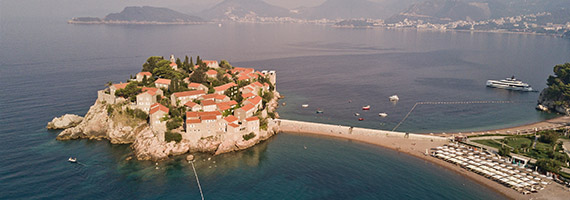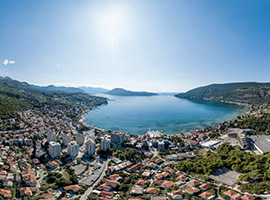
IGALO
Igalo is a small town in the municipality of Herceg Novi with about 4000 inhabitants. This is a city that, although with Herceg Novi it seems to be a unique city unit, it can also be considered a separate settlement. It was named after the same word of Greek origin, which means "coast / beach". Igalo is known as tourist place, and thanks to the radioactive sea sludge from Mud Beach - or as it is also called "Stara Banja" (Old Spa), it is the center of health tourism of Montenegro. Igalo is also known for its unexploited mineral water called "Igaljka". In 1930, an examination of Igalo was performed mud in the laboratory of the famous French spa "Vichy", which definitely confirmed its exceptional healing properties, but only after the Second World War II, on the initiative of Mirko J.Stijepčić, long-established plans for the establishment of a health resort in Igalo were realized. In Igalo is located Church of St. Transfiguration of the Lord, from the second half of the 17th century, which was renewed in 1857.
BEACH ŽANJIC
Žanjic beach is also called Presidential beach, the former famous Josip Broz Tito (president of the former Yugoslavia) chose this bay for private enclosed beach. It is located 6 km from Herceg Novi on the Lustica peninsula. The beach can be reached by a road that leads across the Lustica peninsula, and from Herceg Novi during the summer season, guests are brought by numerous tourist boats. The beach is pebbly, and that is why the water is very clean and transparent. The beach is surrounded by olive trees, in the shade you can relax from the strong sun and enjoy a glass of fine wine. Near the beach there is a port from where you can go to the Blue Cave or the island-fortress Mamula. Mirišta Bay is a 10-minute walk from the main beach Žanjice. The place stands out with its incredible landscape and clean forest air. Along both beaches there are several great restaurants as well exclusive "Fisherman's Village".
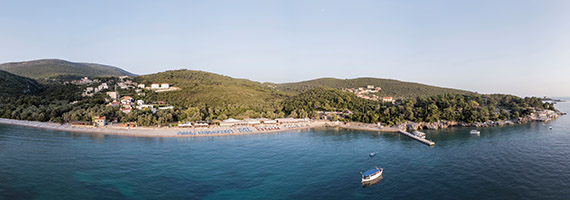
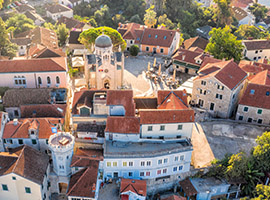
HERCEG NOVI
Herceg Novi is a coastal town in Montenegro, located at the entrance to the Bay of Kotor and at the foot of Mount Orjen. It's administrative center of the Municipality of Herceg Novi with about 33,000 inhabitants. Herceg Novi was known as Castelnuovo (in Italian). Herceg Novi has stormy past, despite being one of the youngest settlements on the Adriatic. The history of different occupations has created a combination of different and picturesque architectural styles in the city. Herceg Novi is the main Montenegrin tourist destination. The sea coast of the city is known for its long promenade 7 km. This fantastic coastal trail provides a special pleasure for walkers at any time of the year. From the promenade you can go down to many smaller orlarger beaches spread a long the entire Novi Riviera. Travel agencies organize one-day boat trips trips from the Lustica peninsula, which are located opposite the city.
Fisherman's village ROSE
Rose is an old fisherman's village located at the entrance to the Bay of Kotor, opposite Herceg Novi. They are facing west, exposed the last rays of the setting sun. By the way, Rose is the place with the most sunny hours during the year, compared to all places along the Bay of Boka. Herceg Novi is about 3 kilometers away, which is a 15-minute boat ride. The inhabitants of this settlement were mainly engaged in fishing in the past, and today Rose is considered one of the elite tourist zones of the Boka Bay. Preserved traditional architecture, old stone houses, fortress Forte Rose and the Church of the Holy Trinity make this fisherman's village one of the few preserved ambient units and the perfect place for a dream vacation!
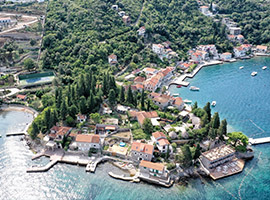
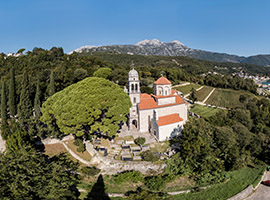
Savina monastery
The Savina Monastery complex is located 2 km east of Herceg Novi in a unique setting of Mediterranean vegetation. It consists of two churches dedicated to the Assumption of the Virgin, a monastery residence with a museum and the church of St. Sava, isolated on a nearby hill. In the monastery archives there are extremely valuable items, among which stand out: the crystal cross of St. Sava from the 13th century, the coffin of the Tvrdoš Monastery from 1615, the shroud from 1642, a silver artifact from 1648, a chalice from 1650, a gospel from 1685, a unique portrait of the Russian Tsar Peter the Great, carved and richly decorated hand and throne crosses, as well as a large number of valuable books and documents. In addition to the museum treasures that are exhibited in the treasury, Savina also has a holy, miraculous icon, the Mother of God, called the Mother of God of Savina. In the big church there is also a small icon of the Mother of God, a contribution of the Russian Empress Catherine the Great.
Lazure hotel & marina
Lazure Montenegro restored the Lazaret building, built at the end of the 17th and the beginning of the 18th century, into a complex of 24 rooms and suites, a total of 54 beds, several restaurants and bars, congress halls, modern kitchen, two receptions, renovated chapel of St. Roch. At every step, you can see the luxury, the sophistication of the design, the commitment to the smallest detail in the renovation and furnishing. At the same time, the construction of the new hotel and apartment building continued, according to the planned schedule. In addition to this five-star hotel, a luxury marina has been built to accommodate smaller and larger yachts with 156 berths. Within the complex there is a swimming pool, SPA center, several restaurants and bars, terraces for rest and relaxation, as well as a large beach with an excellent beach bar. In the complex itself, a beautiful park has been arranged, in which coastal pine trees hundreds of years old have been preserved, and a promenade along the marina has also been arranged.
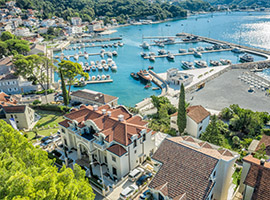
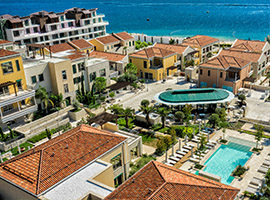
Porto Novi
PortoNovi Resort, one of the most prestigious residential projects in this part of Europe, is located across the entrance to the Bay of Kotor and covers 26 hectares and 1.8 kilometers of exclusive coastal area, with 214 residences available to customers in the first phase. PortoNovi is synonymous with the highest level of service and unobtrusive luxury of world-renowned brands such as D-Marin Portonovi marina, as well as the first One & Only hotel in Europe with Espace Chenot Health Wellness Spa center. In Portonovo there is also a border crossing within the D-Marin PortoNovi Marina. The architecture of PortoNovi settlement is inspired by the authentic charm and character of traditional Boka Kotorska villages and is strongly connected with the sea and the bay. A large number of tourist facilities and catering facilities have been opened within the PortoNovi complex. There is also PortoNovi beach club, with a beach bar offer.
Perast
At the foot of the hill of St. Ilija, opposite the sea strait of Verige, and at the place where the Bay of Kotor and Risan separate, the town of Perast is squeezed. As far as is known, it is the oldest human residence on the shores of the Bay of Kotor. The found remains of the Neolithic culture, as well as numerous archeological finds, testify to a continuous settlement from the Illyrian, Roman, early Christian times until today. What makes Perast a city, regardless of its size, is not only the large number of buildings of public character, but also a refined level of urban complexes that design one urban settlement.
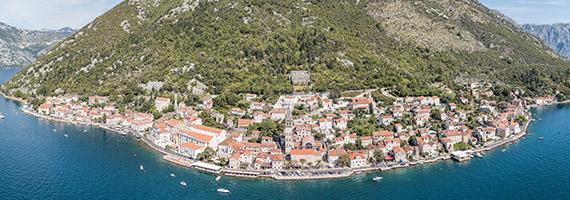
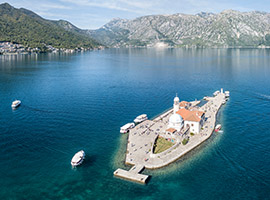
Our Lady of Rocks
This unusual island was created as a result of centuries of intertwining legend and tradition, with the wholehearted help of the inhabitants of Perast and other towns in Boka. Legend has it that on July 22, 1452, sailors found an icon of the Mother of God with a child on a rock in the middle of the sea. From that day, a tradition arose that sailors, upon returning from a successful voyage, lay stones along the shore of Our Lady of Rocks. This man-made island has been built for centuries. To this day, every year on July 22, the locals continue the tradition of rebuilding the foundations of the island and through an event called "Fashinada", they deliver stone to the island by boat and lay it in the depths, so that Our Lady of Rocks continues to adorn the view from Perast. The church contains a large number of works of art by the famous Kotor painter Trip Kokolja, as well as the icon of Our Lady of Rocks, made in 1452 by Lovro Dobričević.
Kotor
For centuries, the city of Kotor, due to its position and importance, was the target of invaders, who passed through this area. It was attacked and besieged by the greatest military forces of ancient times, and the city of Kotor is here today, as we all know it, precisely because of its walls. This masterpiece of fortification architecture, watches over Kotor and its inhabitants, dignified in its strength, testifying to the turbulent past of the city and the courage of the people of Kotor. Built and extended from the 9th to the 19th century, these walls are one of the reasons why Kotor entered the UNESCO World Natural and Cultural Heritage List in 1979. Over 4.5 km long, these walls surround the city, from the glassy sea surface along the Kotor waterfront to the fortress of St. John, on top of the hill of the same name, at an altitude of 260 m. Today, many tourists walk through these walls. Along 1426 steps, the road to the fortress of San Gioovanni, every year, new armies of curious people cross the ancient walls, in order to have one of the most beautiful views of the city of Kotor and the bay under its walls.
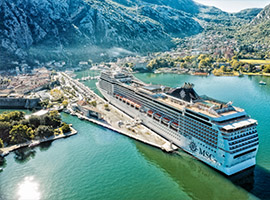
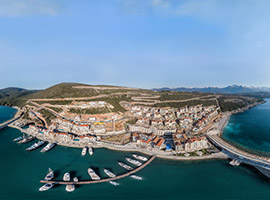
Luštica Bay
Lustica Bay is an elite complex consisting of various apartments, flats, villas and tanhouses located on the Lustica peninsula, about twenty minutes by car to the center of Tivat and fifteen minutes from the airport. Lustica Bay includes: seven hotels, two world-class marinas with 226 berths, various residential facilities, a golf course, shops, cafes and restaurants, sports facilities, several schools, medical businesses and other facilities for city life. Lustica Bay, which is designed in the style of a traditional Montenegrin settlement and is located along the Adriatic coast, is becoming a central point in the settlement and the bay. This nautical tourism facility and port for international traffic, includes a sports club, 24-hour support, repair and maintenance service center, yacht club and crew rooms, 24-hour security and video surveillance, Wi-Fi internet access and the necessary plumbing and infrastructure for electricity supply. More on INSTAGRAM.
Porto Montenegro
Porto Montenegro is a synergy of the attractive way of life of the world's clientele on this Mediterranean coast, marina and luxury nautical resort with real estate for sale and rent. An impressive marina with 450 berths, residences, attractive world brands, international gastronomic experience, elegant bars, sports, entertainment and art points, create a striking identity of the main promenade of Porto Montenegro. The dynamic mix of over 80 retail units includes world fashion designers, a day spa and a yacht concierge, giving the destination a stamp all year round. More on INSTAGRAM.
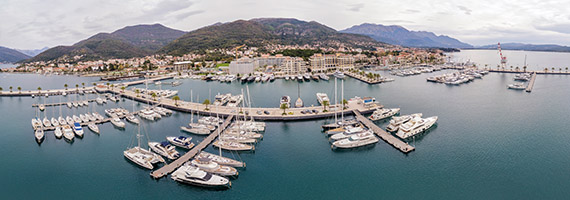
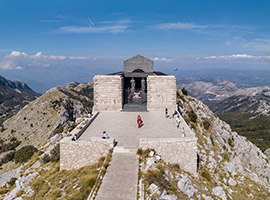
Lovćen
Lovcen National Park encompasses the central and highest part of the mountain of the same name, which is a symbol of freedom and a "holy altar". A mausoleum was erected on Jezerski peak, in the realm of lightning and thunder, to Peter II Petrovic Njegos, the bishop, poet and ruler of Montenegro. Climbing to the mausoleum is the crown of a visit to the National Park, and this imposing building can be reached by road from Cetinje, about 20 km long, and then by overcoming 461 steps to the top of the mountain. The park covers an area of 6,400 hectares. Lovćen is known for its lookouts from all sides - towards the sea, Skadar Lake or the high mountains in the north. Everywhere you look you will experience a unique and unforgettable visual impression. The points on Lovćen from which the Montenegrin beauties can be seen are numerous: Jezerski peak, Štirovnik, the old road from Krstac to the winter resort of Ivanova korita; from the Kotor serpentines - an ancient road that winds like a snake to the sides of Lovćen, a kind of design and construction phenomenon.
Budva
Budva's Old Town forms a unique architectural and urban ensemble, surrounded by medieval ramparts, with a fortress, towers and gates. In the past, it was most severely damaged in the earthquakes of 1667. and 1979. Along the narrow streets, small squares and squares, cafes, boutiques, bars, restaurants, galleries are lined up… so that during the summer months, thanks to performances, concerts and exhibitions, the Old Town really becomes the City of Theater, as the festival that enriches the old seaside town and gives it a special color and charm. Sacral buildings have a special value - the oldest church of Santa Maria in Punta, then St.John, St.Trinity and St.Sava the Consecrated. Next to the church of St.John are the remains of an early Christian basilica, and on the Citadel are the remains of the church of St.Mary. Between the churches is a stage for performances by the City of Theater. In the Old Town you can also see Roman pylons, the walls of the oldest gate of Budva, the Museum of the City of Budva with archeological and ethnographic exhibits, the Modern Gallery and the memorial home "Stefan Mitrov Ljubiša".
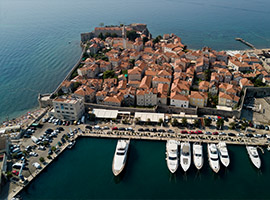
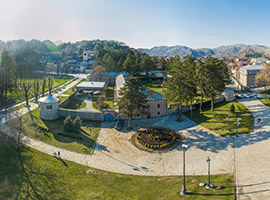
Cetinje
Located in the Cetinje field, below the mountain Lovćen, Cetinje is a city that is a treasure trove of Montenegrin cultural and historical heritage. It exudes 18th and 19th century architecture that springs from the rich greenery of this small town. Cetinje is the capital of Montenegro and the center of the Serbian Orthodox Church in Montenegro. During the reign of King Nikola, numerous embassies were built in Cetinje, which today give the city a specific look. The two most important buildings by which Cetinje is recognizable are the Cetinje Monastery and the 'Billiards Hall'. The Cetinje monastery was built in 1701. The Turks demolished it several times, but the people rebuilt it. It houses the relics of St.Petar Cetinjski, one of the brightest personalities in Montenegrin history. The Cetinje monastery was the spiritual and political center of the Montenegrin people. Njegos was built 'Billiards Hall' for state needs, a building named on the billiards that this exceptional writer, bishop, philosopher and statesman loved to play. Cetinje abounds in museums, there are art faculties, parks, and from peak 'Orlov krš' there is a beautiful panorama of the city and the mountain Lovćen.
Sveti Stefan
Sveti Stefan is an island-hotel and a deluxe resort, connected to the coast by a narrow sandy land and is considered a "business card of Montenegro". About 200 years ago, there were about 100 houses, three churches and more than 400 inhabitants, but a century later, due to the economic crisis, the fishermens who lived there began to leave it. In 1955, the government bought it and created a unique complex, and during the reconstruction, all buildings were preserved in their original appearance. The city-hotel hosted royal families, famous actors, writers, athletes and other celebrities from all over the world.
